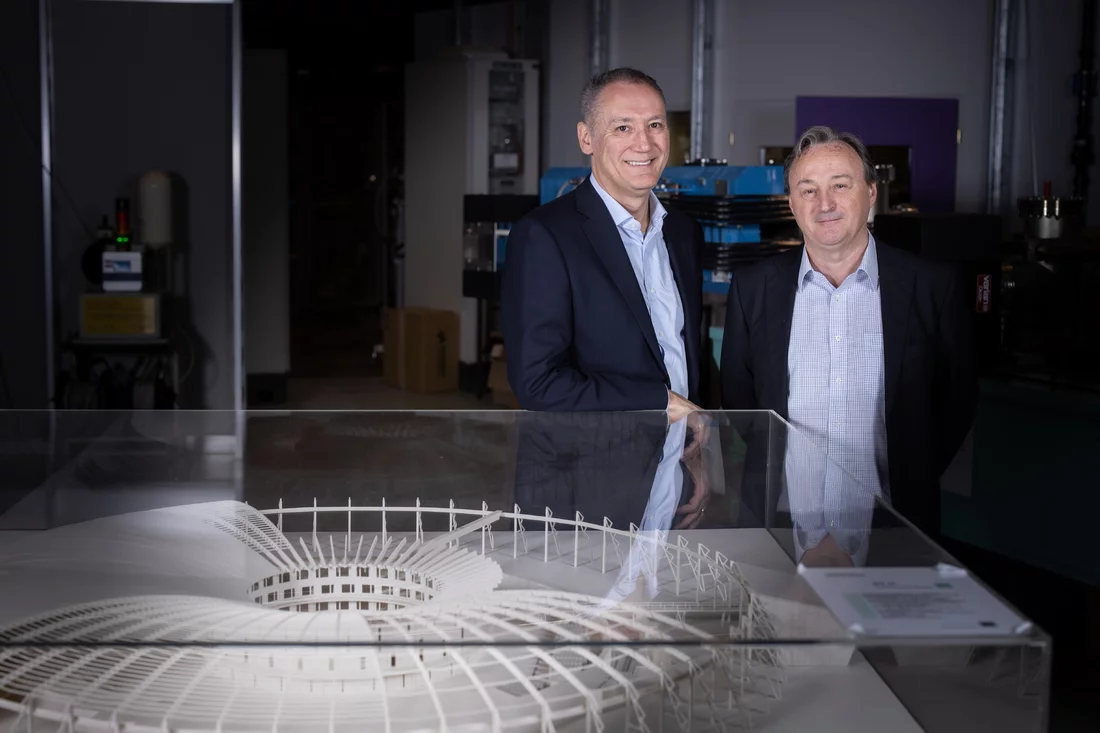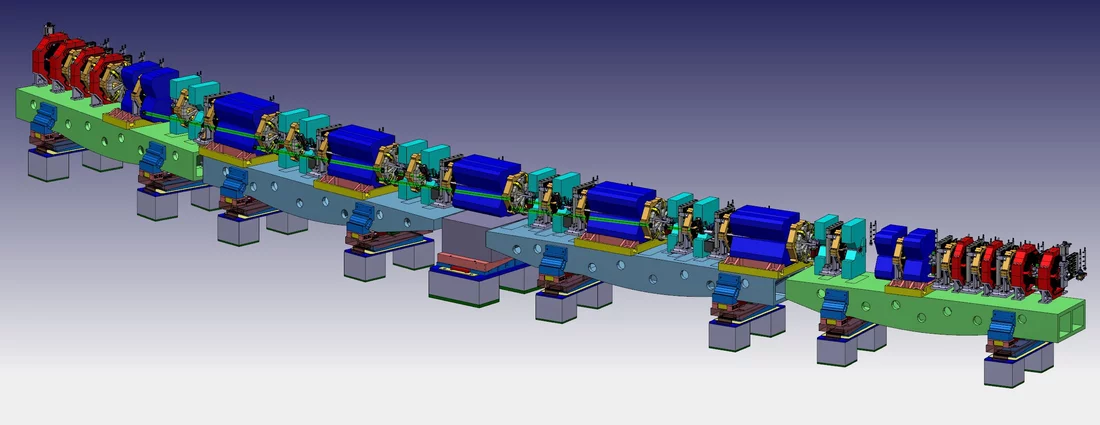The Swiss Light Source SLS is set to undergo an upgrade in the coming years: SLS 2.0. The renovation is made possible by the latest technologies and will create a large research facility that will meet the needs of researchers for decades to come.
Since 2001, "the UFO" has been providing reliable and excellent service: In the circular building of the Swiss Light Source SLS, researchers from PSI and all over the world carry out cutting-edge research. For example, they can investigate the electronic properties of novel materials, determine the structure of medically relevant proteins, and make visible the nanostructure of a human bone.
"Internationally, the SLS has been setting standards for nearly two decades", says Terence Garvey, SLS 2.0 accelerator project head. Now, Garvey continues, it's time for a modernisation. In the coming years, SLS is expected to undergo an upgrade with the project title SLS 2.0. SLS will remain within the same UFO-shaped building, but will get changes in crucial areas inside. Garvey is one of the two project leaders for the upgrade, together with Philip Willmott.
The current state of SLS: This large research facility at PSI is unique in Switzerland. Worldwide, it is one of around two dozen synchrotron light sources. They all produce X-radiation by sending electrons travelling at nearly the speed of light through the tubes of a so-called electron storage ring. On their own, the electrons would fly straight ahead. Keeping them on the roughly circular path of the storage ring requires special magnets, spaced at regular intervals, which deflect the electrons from their otherwise straight path. Each of the curves produced by the magnets results in the electrons emitting light – so-called synchrotron light.
At the current SLS, synchrotron light is generated specifically for use in experiments at 17 points along the storage ring. This is X-ray light and thus high-energy radiation. It is also very intense. If the radiation were in the visible range, we would perceive it as being extremely bright. Experts use the term "brilliance". That means it contains many light particles per second of the same energy in a beam that is both tightly packed and highly collimated. This makes the X-ray light of SLS an excellent tool for cutting-edge research.
Investigations for medicinal agents of the future
The upgrade to SLS 2.0 envisages making this X-ray light even "brighter" and concentrating the beams still more tightly. "That is very important, for example, for the study of membrane proteins", explains Philip Willmott, who oversees the upcoming renovation from the scientific side. Membrane proteins sit in the cell envelope and are responsible for the transport of chemicals or signals to or from the cell. Therefore, they are an ideal docking point for medicinal drugs: Two-thirds of pharmaceuticals target membrane proteins.
But as good as the current SLS is at elucidating many other protein structures – and thus providing drug developers the information they need – it remains difficult to do this for membrane proteins. This is because these form notoriously tiny protein crystals of around ten thousandths of a millimetre or even smaller. "To study these efficiently, you need a correspondingly narrow, parallel, intense beam", Willmott says.
This is now becoming possible: "Technology and engineering have progressed significantly since SLS was first commissioned in 2001. Now we want to exploit and implement these new opportunities", Garvey says.
A chain leads to the upgrade
The list of things needed for a better synchrotron beam includes, first: more and smaller magnets than before – to guide the electrons on a better circular path. In addition, a tube with a narrower diameter – so that the magnets can be brought closer to the electrons. Third, a new vacuum technology – because if the tubes are this narrow, a sufficiently good vacuum cannot be achieved with the pumps currently in use. This is due to a phenomenon familiar to anyone who has ever sipped through a straw: The thinner the straw, the harder you have to draw on it. So there is a whole series of interrelated factors, all of which have now become feasible.
Garvey explains how this became possible: "A technique that has just recently become available allows one to coat the inside of the tubes with a material that absorbs gas atoms similar to how a sponge soaks up water." The name for this is non-evaporable getter coating. Only with this did the path open up for a narrower storage ring tube. This in turn makes it possible to manufacture the arrangement of magnets around the cross-section of the tube to be both smaller and narrower. "In addition, novel magnet and computer-controlled production techniques are needed to fabricate the magnets with micrometre precision", Garvey adds.
Smoother around the curve
These details were necessary to allow a new arrangement of the magnets around the electron storage ring: Instead of producing the "curves" in the ring with a few magnets, they should be realised in SLS 2.0 by means of more and smaller magnets. "Thus, the hitherto somewhat abrupt and thus tighter curves become smoother and more evenly distributed", according to Garvey. Such an arrangement – called a diffraction-limited storage ring, DSLR for short – benefits first the quality of the electron beam, and ultimately also the quality of the synchrotron radiation. Willmott sums it up this way: "As a result, the diameter of the synchrotron beam will shrink, and at the same time will be more collimated."
In practice, what does the upgrade mean to the researchers? "According to our calculations, the parameters of the X-ray beam of SLS 2.0 will be around 30 to 35 times better than the current one", Willmott says. "Since the different experiments use the synchrotron light in individual ways, the data quality can be three times as good, depending on the experiment, while for others it could even be increased by a factor of a thousand, or possibly even more."
People with good ideas
The planned renovation won't be simple. "We must keep in mind that, compared with synchrotron sources internationally, the SLS building and thus its storage ring are rather small", says Garvey. The more space available, the easier it would be to accommodate the many magnets needed to make the electron beam run in large, smooth curves. "So, in this respect we have a slight disadvantage. But we compensate for that, because fortunately we also have a lot of people with good ideas here."
Text: Paul Scherrer Institute/Laura Hennemann


